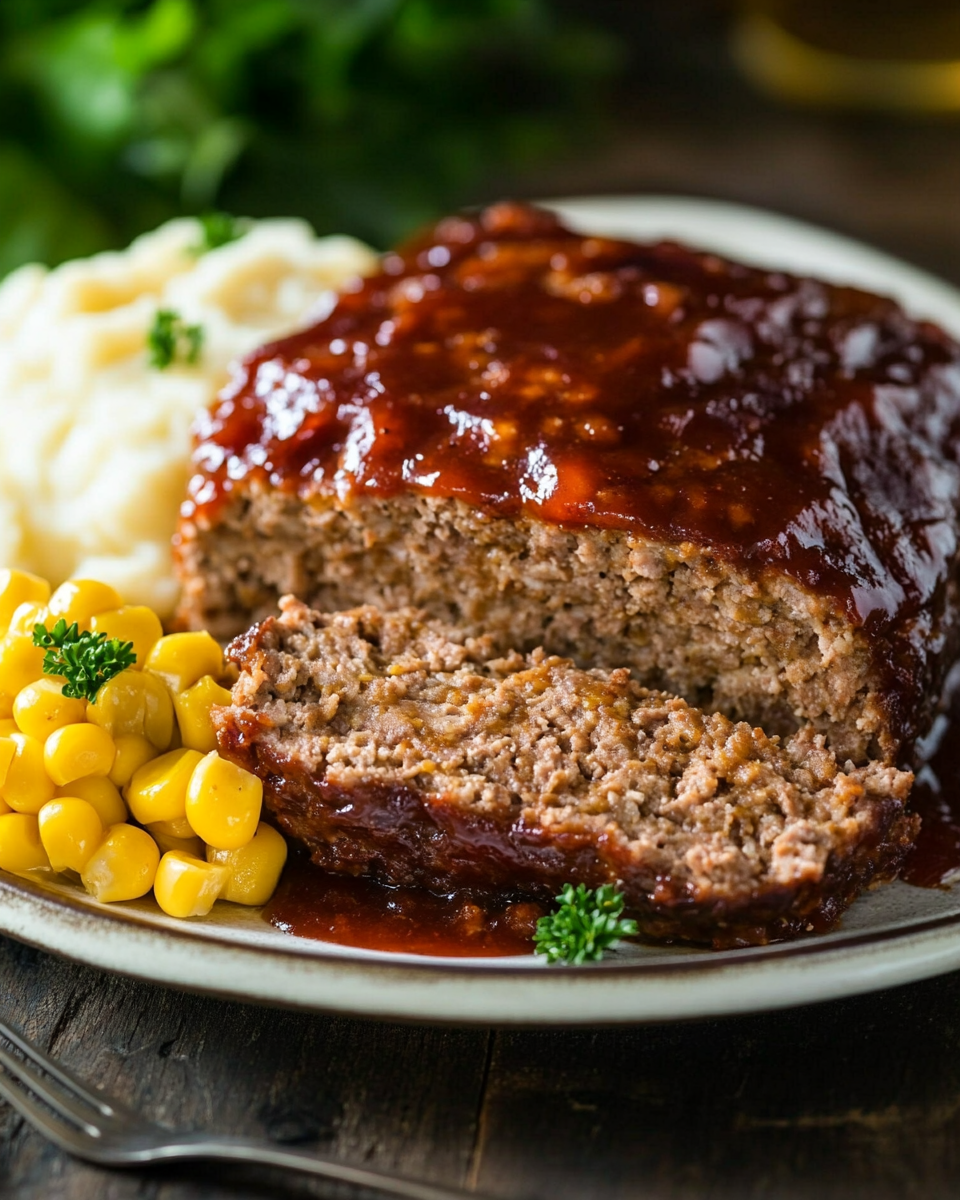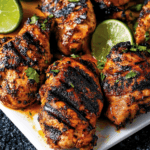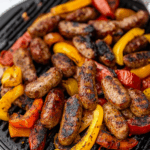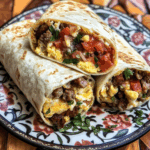This Mom’s Classic Homestyle Meatloaf Recipe is the ultimate comfort food—moist, savory, and packed with flavor. It’s a beloved family favorite that pairs perfectly with mashed potatoes, green beans, or a simple salad. Whether you’re serving it for a cozy weeknight dinner or as a nostalgic weekend treat, this meatloaf delivers warmth and satisfaction in every bite.
FULL RECIPE:
Ingredients
- 2 lbs ground beef (80/20 blend recommended)
- 1 cup breadcrumbs (plain or Italian-style)
- 1 small onion, finely chopped
- 2 cloves garlic, minced
- 2 large eggs
- 1/2 cup milk
- 1/4 cup ketchup
- 1 tbsp Worcestershire sauce
- 1 tsp salt
- 1/2 tsp black pepper
- 1 tsp dried parsley
1.For the Glaze:
- 1/3 cup ketchup
- 1 tbsp brown sugar
- 1 tsp yellow mustard
Directions
- Preheat oven to 375°F (190°C).
- In a large bowl, combine ground beef, breadcrumbs, chopped onion, minced garlic, eggs, milk, ketchup, Worcestershire sauce, salt, pepper, and parsley. Mix until just combined—do not overmix.
- Transfer the meat mixture into a loaf pan or shape into a loaf on a baking sheet lined with parchment paper.
- In a small bowl, mix together the glaze ingredients (ketchup, brown sugar, mustard) and spread evenly over the top of the meatloaf.
- Bake in the preheated oven for 55–65 minutes, or until internal temperature reaches 160°F (71°C).
- Let the meatloaf rest for 10 minutes before slicing and serving.
Nutrition Facts
- Calories: 360
- Total Fat: 20g
- Saturated Fat: 8g
- Cholesterol: 115mg
- Sodium: 580mg
- Total Carbohydrates: 18g
- Dietary Fiber: 1g
- Sugars: 6g
- Protein: 25g
- Vitamin A: 4% DV
- Vitamin C: 2% DV
- Calcium: 6% DV
- Iron: 15% DV
History and Origin of Meatloaf
Meatloaf has a rich history that traces back to ancient Rome, where minced meat was combined with spices and fillers. However, the modern meatloaf as we know it gained popularity in the United States during the Great Depression. It was an economical and efficient way to stretch meat with breadcrumbs, vegetables, and other ingredients. This dish became a staple comfort food, often passed down through family recipes, symbolizing home cooking and resourcefulness. Today, meatloaf continues to hold a special place in many households, loved for its nostalgic value and versatility.
Why Ground Beef is Preferred in Meatloaf
Ground beef is the preferred choice for classic meatloaf because of its flavor, fat content, and texture. The ideal blend is typically 80% lean and 20% fat, which ensures the meatloaf stays moist while providing a rich taste. Fat plays a crucial role in binding the loaf together and preventing it from drying out during baking. Ground beef also absorbs seasonings well, making it a flavorful base. Alternatives like ground turkey or chicken can be used for a leaner option, but they often require additional moisture to prevent dryness.
The Role of Breadcrumbs in Meatloaf
Breadcrumbs act as a binder and filler in meatloaf recipes. They absorb moisture from the meat and other ingredients, helping the loaf maintain its shape and texture. Using breadcrumbs prevents the meatloaf from becoming too dense or crumbly. They also lighten the texture and add a subtle flavor, especially if Italian-style or seasoned breadcrumbs are used. For gluten-free options, alternatives such as oats or crushed crackers can be used, though adjustments to moisture levels may be needed.
Importance of Eggs and Milk in Meatloaf
Eggs and milk are essential in creating a tender and cohesive meatloaf. Eggs act as a binding agent, holding the ingredients together to form a loaf that slices well without falling apart. Milk adds moisture and helps to soften the breadcrumbs, contributing to a moist, tender texture. The combination ensures that the meatloaf is neither too dry nor too dense. Skipping or reducing these ingredients often results in a crumbly, tough loaf.
The Perfect Meatloaf Glaze
The glaze on top of a meatloaf is more than just decoration—it adds a sweet and tangy layer of flavor that complements the savory meat. The classic glaze often includes ketchup, brown sugar, and mustard, creating a caramelized crust during baking. This balance of sweet and acidic flavors enhances the overall taste and adds visual appeal. Variations can include barbecue sauce, tomato sauce, or even a spicy glaze for those who want a kick.
How to Achieve Moisture in Meatloaf
Maintaining moisture in meatloaf is key to making it enjoyable and flavorful. Overworking the meat mixture or using lean meat can lead to a dry texture. Incorporating ingredients like milk, eggs, and finely chopped vegetables (such as onions and garlic) helps retain moisture. Cooking meatloaf at a moderate temperature and allowing it to rest after baking also ensures juices redistribute within the loaf, resulting in a tender bite every time.
Meatloaf as a Versatile Meal
One of the reasons meatloaf remains a family favorite is its versatility. It can be adapted to suit various dietary preferences and flavor profiles. By swapping ground beef for turkey or plant-based proteins, it can cater to those seeking healthier or vegetarian options. Additionally, seasonings and fillers can be customized—adding mushrooms, bell peppers, or different herbs can elevate the dish. It also pairs well with a wide range of side dishes, making it suitable for both casual dinners and special occasions.
Nutritional Considerations
While meatloaf is a comforting and hearty dish, it can also be nutritious depending on the ingredients used. Ground beef provides a good source of protein, iron, and vitamin B12, important for muscle repair and energy metabolism. However, the fat content can be high, so choosing leaner meat or reducing added fats can make it healthier. Incorporating vegetables and whole-grain breadcrumbs increases fiber and adds essential vitamins and minerals, balancing out the meal.
Common Mistakes When Making Meatloaf
Many home cooks struggle with meatloaf turning out dry, crumbly, or dense. One common mistake is overmixing the ingredients, which can make the meat tough. Another is baking at too high a temperature or for too long, causing moisture loss. Not letting the meatloaf rest before slicing is another frequent error, as the juices run out and the loaf falls apart. Using too little binder or skipping key ingredients like eggs and milk can also result in a crumbly texture.
Serving Suggestions and Pairings
Meatloaf pairs wonderfully with classic sides like creamy mashed potatoes, steamed green beans, or roasted carrots. For a lighter option, it can be served alongside a fresh salad or sautéed greens. The tangy glaze also complements tangy or slightly sweet sides, such as coleslaw or roasted sweet potatoes. Leftover meatloaf can be repurposed into sandwiches or crumbed to make meatloaf sliders, offering a delicious second meal.
Storing and Reheating Meatloaf
Meatloaf stores well in the refrigerator for 3 to 4 days, making it an excellent make-ahead meal. To keep it moist when reheating, cover the slices with foil and warm them gently in the oven or microwave. Adding a splash of broth or water can help retain moisture during reheating. For longer storage, meatloaf can be frozen in airtight containers for up to 3 months. Thaw it overnight in the refrigerator before reheating for best results.
Meatloaf in Popular Culture
Meatloaf has become more than just a dish—it’s a cultural icon in many households, especially in America. It’s often referenced in movies, TV shows, and literature as a symbol of comfort food and home cooking. Many families have their own secret recipes handed down through generations, making it a sentimental and nostalgic meal. This cultural status reflects its ability to bring people together around the dinner table and evoke feelings of warmth and familiarity.
Modern Twists on Classic Meatloaf
While the classic meatloaf recipe remains beloved, many chefs and home cooks experiment with modern twists. These include adding international spices like cumin or chili powder, stuffing the meatloaf with cheese or vegetables, or topping it with unique glazes like balsamic reduction or sriracha mayo. There are also keto-friendly versions that omit breadcrumbs and incorporate almond flour or cheese for binding. These innovations keep meatloaf exciting and adaptable to contemporary tastes and dietary needs.
Conclusion
Mom’s Classic Homestyle Meatloaf is more than just a dinner option; it’s a timeless recipe rooted in history and comfort. Its combination of savory ground beef, moisture-retaining ingredients, and a flavorful glaze make it a satisfying meal for all ages. Beyond its taste, meatloaf represents family tradition, versatility, and the joy of home cooking. Whether enjoyed fresh, reheated, or reinvented with modern twists, this classic dish continues to hold a cherished place in kitchens and hearts worldwide.






